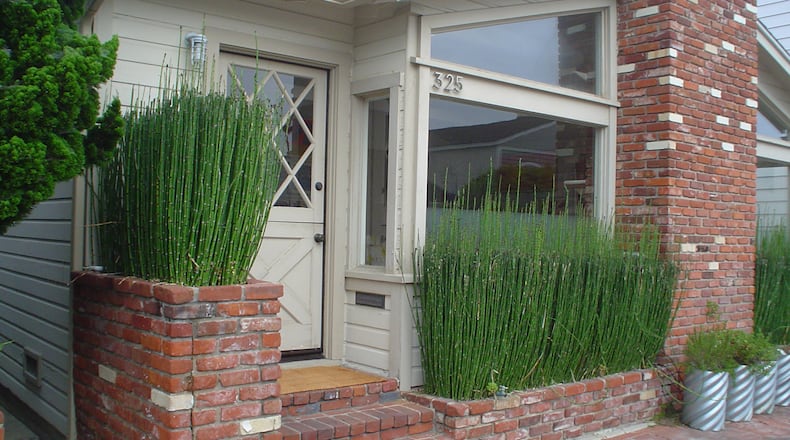It was the most important wild plant for pioneers settling the West by wagon. The women knew it made a perfect pot scrubber. Equisetum hyemale, named horsetail for the similarity of its stems to hair of a horse’s tail, is a very primitive native plant. It’s actually a living fossil that contains an abnormally high silica content in its cell walls that makes it abrasive. Native Americans also used it as sandpaper to smoothen and balance arrow shafts.
When bundled, tied and blunt cut, this is the SOS pad of the Old West. Nothing works better on cast iron and enamelware. It was known in medieval England as pewterwort. The silica could clean soft metal without leaving scratches, so it was widely used in the Old World, too.
Horsetail is a species of wetlands, both at the water’s edge and far from it. It produces rapidly spreading roots that send up new shoots to expand into a vast network. Its role in nature is to use aggressive roots to bind the soils of banks and shorelines against erosion from the effects of high water. However, such rooting also makes the plant a super pest where it becomes well established, and can be as difficult to extricate from your soil as bamboo.
Horsetails date back relatively unchanged for 300 million years. During the era of dinosaurs, the plants were 20 feet tall and with much larger diameter. They are so primitive they achieved their ultimate form before seed plants appeared on earth. They reproduce by spores, just like ferns, except they’re carried in little cones at the top of the stems.
Horsetails are a great native for creating fun and unusual effects. They are ideal for suggesting water where it does not exist. The reedlike appearance tells us subliminally that water is nearby, so we naturally believe it’s there. Add a few boulders and you have a faux spring. One way to add horsetails without worrying about the invasiveness is to leave them in a pot and bury it to create a root barrier. You’ll get a nice tall columnar reed effect that works well with drip irrigation emitters.
Equisetum has found its way into our cities, too, often as a problem-solver for long, narrow openings in paving. The slots occur at foundations and where remodeling has left odd spaces that won’t support most plants. The universal solution was to pack them with equisetum until they discovered what happens when the slot becomes so dense with rods and surface roots that water cannot penetrate. This dries out the plants and makes their tips turn gray. Their coloring changes from nice green to an insipid olive. Thankfully this practice seems to have gone out of fashion for the time being.
When stands of equisetum are cut during the summer, they also die back due to the drier conditions. Buzz cutting the tops only encourages more moisture loss, which leaves the topmost tissues dehydrated. They almost never look good after cutting, losing their natural beauty. When these plantings inevitably get ratty due to the lack of water penetration and pruning moisture loss, the only option is cut them to the ground and renew the whole thing.
To grow horsetails at your water feature, don’t put them in the ground. It’s best to keep them in containers buried or hidden behind foliage and boulders with drip irrigation. They can draw from the accumulated moisture for great color and lush looks even in the heat. In the far West they do nicely in bright shade and on the patio in pots. As a marginal, you can also grow them as potted aquatics in a big container of water or in a real water garden where dragonflies will come to perch on the tips.
If you’re not a gardener, look for horsetails on walks and hikes. Consider that they have been there since dinosaurs roamed. Show your kids how find them. Try making brushes of your own. Then plant one for the little ones who are always so excited about fossils so they get to grow up with a true living fossil that hasn’t gone extinct for 300 million years.
———
Maureen Gilmer is an author, horticulturist and landscape designer. Learn more at www.MoPlants.com
About the Author
Keep Reading
The Latest
Featured


